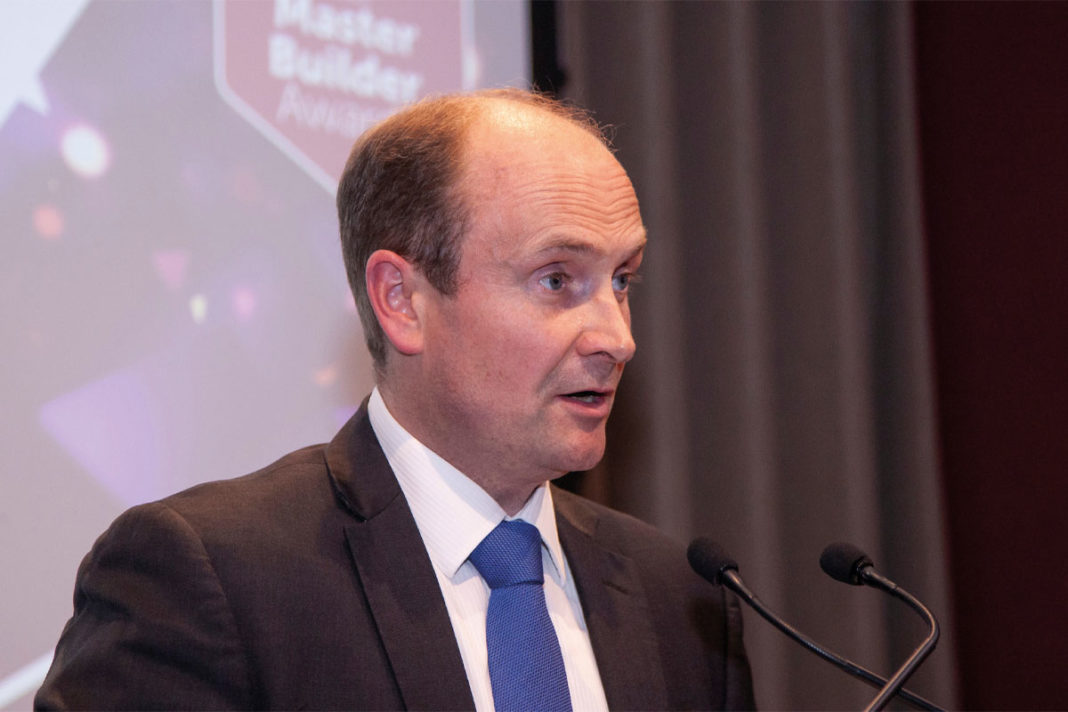
2024 was a challenging year for Scotland’s construction sector with skills gaps, political uncertainty, tight margins, and construction inflation all posing significant issues for firms large and small.
As we step into 2025, Project Scotland asked many stakeholders from across the sector to predict what lies in store over the next 12 months.
The looming rise in employer NI contributions and ongoing issues around late payments and restricted budgets are expected to pose problems. However, the responses suggest there are plenty reasons for optimism, with a rise in retrofit projects, increased integration of advanced technologies, and innovative approaches to tackling the climate and housing emergencies creating a number of opportunities for businesses to prosper.

Ian Hughes, engagement director, Scotland, of the Construction Industry Training Board (CITB), believes the Scottish construction industry is poised for growth this year, with the organisation’s latest Construction Skills Network report showing output is projected to rise by 2.1% annually until 2028.
“A major hurdle will be addressing the need for 26,100 additional construction workers over the next five years. The Scottish Government’s Infrastructure Investment Plan to 2026, outlining its multi-billion-pound investment strategy, will offer significant business opportunities for Scottish construction, demonstrating a construction pipeline for the industry, as well as the urgent need to address skills shortages.
“The coming year will see a trend of balancing growth with innovation, requiring strategic collaboration to address workforce gaps and improve productivity within Scottish construction. Continuing to develop a competent workforce, aligned with input from industry, government, and CITB, will be essential to effectively meet demand.”

Joanne Hemmings, associate at Holmes Miller, said 2025 must be the year when sustainable, energy-efficient design is embraced as the new normal way of working.
“Whether it’s the approach to a brand-new project or the retrofitting of an older building, our industry must become more proactive and ambitious in responding to the climate emergency. Our public sector work, especially in education and leisure, continues to focus on retrofit and reuse, with a drive towards making existing estates safer, fit for purpose, and ultimately zero carbon.
“While restricted budgets continue to present challenges, long-term impacts must be a key factor in design decisions, particularly with regards to energy consumption and the comfort of building users. When design and construction standards like Passivhaus are adopted, our collective understanding, expertise, and knowledge across the sector grows, benefiting everyone.”

Gordon Nelson, Scotland director at the Federation of Master Builders, said feedback from members on 2024 is that workloads have been solid. “Indeed, Scotland bucks a rather dispiriting trend seen across the other home nations. This on the two key measures of overall workload for builders and enquiries for new works: from the results from FMB’s State of Trade Surveys.
“So, we must be in a good place then as 2025 unfolds? It’s not that simple. With margins tightening and a rise in unrealistic expectations from clients, I’m concerned that 2025 will bring in more payment disputes and conflicts. The workloads may be there, but it is getting tougher for contractors to get paid on time.
“We also know that builders continue to grapple with the challenge of sourcing skilled labour across the key trades. April is when the increases to employer National Insurance contributions kick in. It’s already tough enough for employers to recruit the next generation of master builders, so this additional cost is unwelcome.”

Chris McGhee, commercial director at HFD Construction, expects the upper end of the commercial property market will continue to be influenced by organisations’ need to foster a common purpose and shared team ethos – a key driver of the return to the office.
“To attract and retain the best people employers need to offer the best-in-class facilities and amenities. Quality construction is, therefore, essential. A focus on investing in pre-construction design co-ordination and build feasibility can pay dividends in providing client certainty and optimising quality; minimising the likelihood of costly drawn-out delays and legacy quality issues.
“Contractors have an opportunity to double down on quality and inspection controls at each milestone and there will likely be a resurgence in independent stress testing. Evidencing that we can consistently deliver the highest quality construction can increase the attractiveness of Scotland as a great place to invest in large-scale projects.”

Morag Angus, head of property and construction and chief surveyor at Scottish Government, and Peter Reekie, chief executive of the Scottish Futures Trust, and both co-chairs of the Construction Leadership Forum’s Transformation Action Plan, issued a joint statement saying they have been encouraged to see the sector embrace the need for change across our industry, forging better networks, galvanising knowledge sharing and new ways of working.
Morag Angus said, “2024 has been a year of progress and innovation despite intense cost pressures and major changes within the public sector, but 2025 needs to be the year that the industry benefits from change rather than just feeling affected by it. Amplifying micro and SME voices at a government level continues to be a priority, and we need to hear from a broader range of experiences within the construction sector. The new graduating pricing mechanism could be a game changer in public sector procurement and lead to better quality and more competitive tendering processes that will benefit the whole industry.”

Peter Reekie added, “It’s crucial we bring sector concerns to national level and amplify the voices of those affected by policy and strategic decisions. Utilising the knowledge of our industry through groups like the Construction Leadership Forum has helped established actions that put skilled workers at the heart of informing decision making.”

In the wake of Grenfell, cladding remediation continues to be a serious issue with wide-ranging implications. The Housing (Cladding Remediation) Scotland Act 2024 empowers Scottish ministers to, among other things, set up a responsible developers’ scheme. Michael Collins, a partner in Anderson Strathern’s construction dispute resolution team, said the details will be fleshed out in regulations but what is clear is that the ultimate goal is to make developers contribute towards assessing and remediating dangerous cladding.
“In addition, powers have been transferred from the UK Government to enable enactment of a Scottish Building Safety Levy. This is expected to be a self-assessed tax on new residential projects to fund Scottish Ministers’ cladding remediation programme. This tax on developers may indirectly impact on the supply chain, whose margins are already slim. The Scottish Government has opened up a consultation to give stakeholders a say on the proposals.”

Sarah Lewis, research & policy director at Passivhaus Trust, believes Scotland is fast becoming a global Passivhaus hotspot, with almost 60% of new Scottish schools targeting the standard and Dunfermline Learning Campus set to be the UK’s largest Passivhaus educational building.
“The world is watching the Scottish Government’s pioneering Scottish Passivhaus equivalent policy. We are still awaiting the fine details of that policy. A second consultation in summer 2025 will determine the specific changes to performance targets and compliance processes. We are positive that our recommendations will have been taken on board so that Scottish building standards have the accurate tools and absolute energy targets essential for any standard aiming to be a Passivhaus equivalent.
“We know that the Scottish construction industry is up to the challenge of building to Passivhaus levels of excellence. We just need a transition period to enable the industry to upskill. It is not rocket science and Scotland is ready for lift-off!”

Maxi Construction MD John Aitchison is anticipating continued use of frameworks for the procurement of construction works by public sector clients, as pressure on resources persists.
“Framework contracts allow us to build on established relationships, and create new relationships with clients, based on knowledge, trust and providing value for money. We expect to see an increase in the trend for retrofit and Passivhaus projects as clients look to de-carbonise their property portfolios and provide energy efficient, sustainable buildings for the future.
“We’ve invested in training and a number of our project team members have experience in delivering retrofit and Passivhaus projects, an example being our award-winning annexe at Sciennes Primary School in Edinburgh.”

Susan Jackson, joint MD of Campion Homes, said it is encouraging to begin 2025 with renewed optimism following the restoration of funding for affordable homes.
“We look forward to this vote of confidence unlocking more development sites for our affordable housing partners. With a declared housing emergency, we are eager to ensure more people have the homes they need and deserve. However, the challenge remains in longer term planning. We call on the government to provide a longer term commitment to the funding of affordable housing to allow us all to invest in this critical industry.
“Building any new home at an affordable price remains challenging. The cumulative impact of regulatory changes will challenge budgets. The imminent move towards a Scottish equivalent to Passivhaus, the requirements for photovoltaics, EV charging points, heat pumps, and other evolving technologies will continue to drive up costs. The government must recognise the need to strike a balance if they are to meet their targets.”

Lynsay Bell Manson, MD at architect practice Studio LBA, said the sector will continue to face challenges around the climate and housing crisis, alongside the professional crisis in terms of ever eroding fee levels to try and get projects to stack up.
“However, positively we have seen an increase in clients looking to surpass the required Building Regulations standards and provide more sustainable low energy buildings throughout 2024 and with the introduction of the Scottish Passivhaus equivalent in 2025, we will continue to see an increased commitment to improving the quality of our projects.
“Reuse remains a strong focus for LBA and our extensive conservation experience alongside our Passivhaus skills have made us well placed to work on some fantastic adaptive reuse projects for prestigious developers and clients across Scotland. Protecting the future legacy of our cultural and historically significant buildings has remained at the heart of our work and by improving a buildings energy performance and ensuring its adaptability and flexibility for the next generation, we are achieving this goal. This focus on sustainability has been really encouraging for us as our practice pushes towards achieving net zero operations and we continue to upskill more of the team on achieving Passivhaus, retrofit and various sustainability qualifications.
“Looking ahead with a focus on the housing crisis, our practice will be looking at innovative ways to increase densities across our development sites, providing a rich mix of uses and focus on landscape led developments within our design-led masterplans. However, local authorities need to get on board, drastically improving on their timescales and level of engagement, working with our clients and design teams more collaboratively as we all try and work towards meeting the targets for both climate and housing. The system is currently not working and will be a block towards creating a more sustainable and resilient Scotland.”

Alan Wilson, MD of SELECT, said the electrification of Scotland’s economy presents significant opportunities for electricians.
“As the country begins to transition to renewable energy and decarbonised systems, demand for skilled electricians will rise sharply. Renewable energy projects, such as wind turbines and solar farms, will require extensive electrical expertise, and this coupled with the electrification of transport, along with the transition to electric heating systems like heat pumps, will create significant additional work opportunities.
“The shift toward a net zero economy ensures sustained, long-term demand for electrical professionals. By contributing to Scotland’s sustainability goals, electricians not only enhance their career prospects but also play a vital role in building a greener future. These opportunities make electrification a pivotal moment for the electrical trade.”

Alex Goodfellow, CEO at Donaldson Offsite, said that after a year of political change and promises, 2025 needs to see some clarity and action.
“While it’s been promising to hear our new UK Government pledge to build 1.5m new homes, there has been a lack of substance or any real plan to indicate how we’re going to make this happen. There will need to be an overhaul of the planning system along with interest rate cuts – or the return of a version of Help to Buy – to help homebuyers to allow some recovery in market conditions. We must also consider a pathway towards the adoption of the proposed Part Z of the Building Regulations – focused on embodied carbon – in order to achieve true zero carbon homes.
“The best way to address housing challenges and meet net zero carbon targets is by using MMC technologies and low carbon structural timber. It’s time to make it happen.”

MJ O’Shaughnessy, MD of Will Rudd Glasgow and Ireland, said, “It’s no secret that the last several years have been tough from a construction perspective as the industry recovered from the effects of the pandemic. Despite the challenges we face, whether the drive towards net zero targets or the housing crisis, our diversification in all sectors and project variety has been our key success and we are anticipating a continued positive outlook for the industry in 2025.
“There is definitely greater enthusiasm from across the built environment to work together to tackle the challenges we have been facing and our in-house specialisms, particularly facade engineering, conservation engineering and temporary works are helping to bolster just that. Innovation, efficiency, diversification and sustainability will continue to be a driving force, with a heightened focus on green building practices and the use of eco-friendly materials.
“Collaboration across disciplines will be crucial, fostering innovative solutions that address both current and future needs. Additionally, the demand for conservation engineering is expected to grow, driven by the industry’s commitment to preserving historical structures while meeting modern standards.”

John Forster, chair of Forster Group, believes the renewable energy sector, particularly solar and battery storage, is poised for significant growth.
“The closure of the UK’s last coal-fired power station in September 2024 marked a pivotal shift towards cleaner energy. The Labour government’s move to nationalise the National Grid as the National Energy Systems Operator (NESO) is a crucial step in prioritising renewable energy. We foresee a rise in smart energy systems, integrating large-scale and microgeneration of solar power with advanced storage solutions. This transition is vital for meeting climate targets and ensuring energy security.
“The built environment faces challenges in retrofitting and constructing energy-efficient homes, compounded by skills shortages and high costs. Collaboration between national and devolved governments is therefore essential. At Forster Group, we are dedicated to leading this transition, providing integrated solutions that support a sustainable and resilient future.”

Kenny Leitch, principal investigator at HCI Skills Gateway and associate professor at Edinburgh Napier University, said more investment in skills programmes at an early age is critical so that misconceptions about construction industry careers are left in 2024.
“This year we saw a 28% decline in recruitment to HNC programmes and a 42% drop in entries to HND programmes offered by further education institutions – a reflection of the ongoing shortage of skilled labour into the sector and the misperceptions of construction careers among school leavers. Construction isn’t just hard hats and hi-vis vests – there are many roles which offer strong industry progression, from office-based careers to those focusing on design and refurbishment.
“With the rapid emergence of digital skills and AI across the sector, it’s an exciting time to get involved. Despite this, many young people are still unaware of the opportunities available to them. Lack of availability across academic courses to set them up for success is also creating barriers. To recruit new talent to the sector in 2025, we need strategic conversations between education and trade bodies at national level to ensure continued investment in skills programmes.”

Ciara Johnstone, quantity surveyor at Akela Ground Engineering, stated that the construction and built environment sector is poised for significant advancements.
“We anticipate further integration of sustainable practices and advanced technologies, ensuring that the construction industry not only meets demand but also sets new standards for quality and reliability.
“At Akela Ground Engineering, we are excited about the continued adoption of innovative solutions like our ABeam precast foundation system. Since its launch in February 2024, ABeam has demonstrated remarkable efficiency and sustainability, helping to address the housing emergency by speeding up the housebuilding process.”

Steven Simpson, MD of Cruden Group, said we are seeing a time of renewed cautious optimism in housebuilding and at Cruden.
“Last year we re-structured our business to ensure we are best placed to maximise opportunities for affordable and private housing in the face of continually evolving market dynamics across both sectors. This strategic decision is already proving very successful, and we enter into 2025 with an extremely robust pipeline to deliver more than 4,500 new affordable and private homes. Recently we have secured planning at landmark new developments including the first phase of the Granton regeneration with 847 net zero homes, and 172 energy efficient new homes at one of Scotland’s best connected new communities, Millerhill.
“The Scottish Government’s commitment to inject £768m for more desperately needed affordable homes is welcome news. This will see 8,000 more affordable homes delivered to help tackle the housing emergency and give a vital shot in the arm to unlock further new developments across Scotland.”

Gary Gray, general manager of Muir Timber Systems, said that if Scotland is to build the homes needed, we will need to do so more sustainably and efficiently.
“Using off-site manufactured trusses and timber kits can help support this. As timber is lighter than traditional masonry builds, this reduces the need for deeper foundations or piling, meaning it makes more developments across Scotland more viable when the ground conditions are more challenging.
“Over the next year it’s likely that sustainability will continue to be a priority for homebuilders and even their own customers who are increasingly wanting to know that their home has been built as environmentally friendly as possible. This includes having a supply chain where they use materials from sustainable sources and are manufactured responsibly. Building from our solar powered factory in Inverkeithing, this is something we are already delivering for a number of housebuilders across Scotland.”

Jon Dunwell, CEO, Morris & Spottiswood Group, said, “After last year’s General Election, the construction industry had to weather uncertainty and delays in investment decisions, as we collectively braced ourselves for inevitable policy changes. Now with a new government, whatever your politics, clarity brings renewed market confidence and opportunities.
“As we move into 2025, although we still face the widely acknowledged legacy issues such as skills gap shortages and rising construction inflation, something that has been particularly felt within the M&E sector, I do feel there is a huge amount to feel positive about. This is because despite the challenges, many within the supply chain, including ourselves at the Morris & Spottiswood Group, have already committed to and are acting upon the need for a cultural shift in construction.
“Early engagement and true collaborative partnerships as well as clear procurement, digital and green strategies are crucial to de-risk projects across all sectors in which we work, and ultimately improve the industry for us all.”

Kieran Graham, MD at Tulloch Homes, part of the Springfield Group, said 2025 will be an extra special year for Tulloch as it enters its 100th year in the homebuilding sector.
“Next year will also see great opportunities emerge as we seek to address the housing challenge set by The Highland Council to double housing output over the next ten years. The creation of the Inverness and Cromarty Firth Green Freeport and the new SSEN powerlines will bring investment, jobs and infrastructure and, with Tulloch’s vast experience delivering across tenures, we’re ready to help deliver the quality housing that these projects will need to be successful. This will include a response to the Council’s welcomed call for new housing sites.
“In grabbing this opportunity for the Highlands, we look forward to working with partners – old and new – as well as the communities in which we are building to ensure the benefits of housebuilding are shared locally.”

Julie Moulsdale, MD of built environment specialist communications consultancy, Perceptive Communicators, thinks 2025 is likely to be a much more positive year for the industry.
“The winds of political change are starting to blow in a better direction since before Covid. This will hopefully release funding and planning strangleholds which have stifled this key economic sector.
“Fast-tracking the unlocking of these blockers will allow the built environment to perform to its full potential. This will not only benefit those in built environment, but also help supercharge other key sectors like life science, technology and manufacturing.”

Several working group co-chairs who are leading on Scotland’s Transformation Action Plan as part of the Construction Leadership Forum also provided their hopes and predictions for 2025.
Colin Campbell, co-chair of the Quality Working Group and associate director at the Scottish Futures Trust, hopes to see even more focus on quality when it comes to decision making.
“In February, the Construction Quality Improvement Collaborative (CQIC) will reach its 2nd anniversary. Since its launch it has reached 115 organisations that have committed to the Quality Charter which is at the heart of the campaign to create a sustainable quality culture across construction in Scotland. Those organisations employ some 43,000 people who are engaged in construction.
“Whilst this is a healthy number, it’s still a relatively small proportion of the sector. CQIC would like to drive the number of committed organisations to at least 150 and to see evidence that quality is being put at the heart of all decision making, bringing benefits for all concerned. We will be publishing further guidance to support and transform the sector and would like to see that, and the guidance we published previously, used to best effect.”

Elaine Ellis, co-chair of the Skills Working Group and skills planning manager at Skills Development Scotland, said, “With major infrastructure projects at a scale not seen for decades, plus the housing emergency, the rise of renewables and the move to decarbonise our homes, a skilled construction and built environment workforce is more vital than ever.
“We will continue to promote the benefits of skills and training at all levels of the industry and work closely with sector partners and employers who will recruit, train and upskill the workforce needed in Scotland.”

John Brown, co-chair of the Supply Chain Working Group and group MD at Veitchi Ltd, said, “As we have said many times before, we have a strong sector with excellent leaders, but there is so much more we can achieve together. Therefore our priority for 2025 will be to further engage with industry at all levels, reinforcing the many advantages of strengthening local supply chains to ensure the benefits of construction are spread more widely and fairly.”

Fiona Harper, co-chair of the Fair Work Working Group and chief executive of The Scottish Electrical Charitable Training Trust, wants to see the construction sector come together to secure a fair work outcome.
“Many employers in the Scottish construction industry implement fair work practices, provide safe and secure working environments, and promote positive workplace cultures where employees are engaged and have their voices heard – but not all. There will always be a moral imperative to deliver Fair Work, but there is also an economic imperative – Fair Work is a model for innovation and success.
“In 2025, the Fair Work Group will continue to promote the need for equality of opportunity across the industry at all levels. Our aim is to deliver a Fair Work Charter to help and encourage employers embed diversity and inclusion plus fair work practices in the workplace. But we can’t do it alone – we need the whole sector to be brave, embrace change and be willing to work together to help achieve a fair work outcome for the industry. Only through combined, collaborative effort can we make significant strides in the delivery of Fair Work for all.”

Lynsey Brydson, co-chair of the Digital Working Group and director – impact programmes at BE-ST, said, “In 2025 we’re going to be revisiting the digital working group’s aims to ensure that we’re maximising the value that we can create. We’re going to have a much greater focus on collaborating and supporting the aims of the other working groups and will be stressing the message that digital can be an enabler of positive change when implemented correctly.
“We’ll be continuing to promote examples of best practise and signposting to existing resources.”











